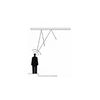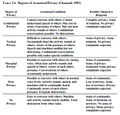atom03:Sound
Contents |
what is sound?
Sound is a mechanical wave that is an oscillation of pressure transmitted through a solid, liquid, or gas, composed of frequencies within the range of hearing and of a level sufficiently strong to be heard.
sound reflection and space
barrier due to buildings
When a receiver is standing behind a row of buildings, it's likely that sound will be perceived as coming from the side away from the source. this is because the sound is reflected from another building behind the receiver. The sound coming by way of this path is louder than the direct path over the barrier due to the reduced barrier effectiveness at the elevation of the reflection point.
Flat surfaces
A flat surface is effective in distributing sound. If the surface is large enough and positioned correctly, a flat surface can project sound toward the listeners. Flat surfaces can also cause problems if placed incorrectly. For example, a flat, reflective rear wall in an auditorium will reflect sound back toward the speaker, this is called "slap-back". Parallel reflective walls can create a reflection between the two surfaces, this is referred to as "flutter echo" or "standing wave". Two flat surfaces coming together to form a peak can act as a megaphone and amplify the reflected sound.
Concave surfaces
Concave surfaces cause reflections to be concentrated rather than dispersed. This causes an abundance of reflection to be heard by the listeners in the focal point, or the point at which all of the reflections are focused. Reflections can also travel along a concave surface bringing delayed reflections around the room.
Convex surfaces
Convex surfaces are the best surfaces for distributing sound. They provide a wide spread of reflected sound.
barrier due to buildings
Barrier due to buildings sometimes produces a curious phenomenon. When a receiver is standing behind a row of buildings, not infrequently the sound will be perceived as coming from the side away from the source. this is because the sound is reflected from another building behind the receiver. The sound coming by way of this path is louder than the direct path over the barrier due to the reduced barrier effectiveness at the elevation of the reflection point.
barrier due to buildings
Barrier due to buildings sometimes produces a curious phenomenon. When a receiver is standing behind a row of buildings, not infrequently the sound will be perceived as coming from the side away from the source. this is because the sound is reflected from another building behind the receiver. The sound coming by way of this path is louder than the direct path over the barrier due to the reduced barrier effectiveness at the elevation of the reflection point.
human perception and reaction to sound
sound vs noise
Sound is a form of energy that is transmitted by pressure variations which the human ear can detect. When one plays a musical instrument, say a guitar, the vibrating chords set air particles into vibration and generate pressure waves in the air. A person nearby may then hear the sound of the guitar when the pressure waves are perceived by the ear. Sound can also travel through other media, such as water or steel.Apart from musical instruments, sound can be produced by many other sources - man's vocal cord, a running engine, a vibrating loudspeaker diaphragm, an operating machine tool, and so on. Noise is a combination of different sounds, that cannot be clarified. Usually the sound of a violin is referred to as music - is something pleasing. Depending on other factors, the sound may be perceived as noise.Noise perception is subjective. Factors such as the magnitude, characteristics, duration, and time of occurrence may affect one's subjective impression of the noise.
sources: environmental protection department - goverment of Hong Kong / Long, Architectural Accoustics. Elsevier Academic Press, London 2006.




